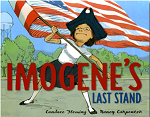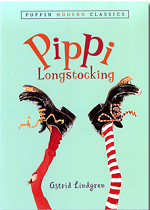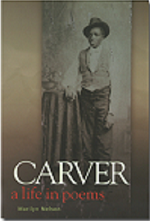On July 4 in the United States, we celebrate Independence Day and independence is an important characteristic of some of the great characters in children’s books. To round out Fourth of July barbeques, I’ve chosen a dozen picture books, novels, and works of nonfiction that celebrate individuals who know what it means to stand on their own.
Picture Books
MISS RUMPHIUS written and illustrated by Barbara Cooney
“What makes Miss Rumphius memorable for many young readers, however, is the exquisite artwork, executed in the purples, pinks, and blues of the lupines—breathtaking landscapes marked by their beauty and soft color. With its positive and idealistic message of making the world a more beautiful place, this book has captivated both young readers and the parents and teachers who share the book with them. It reminds all of us that with just a little effort we can add beauty to our world.”
IMOGEN’S LAST STAND written by Candace Fleming and illustrated by Nancy Carpenter
 “As Imogene works to have the house declared a national landmark, the book emphasizes that important events in history often occur in the smallest of towns. Although it addresses the serious topic of historical preservation, the book is executed with humor and panache. This picture book combines a delicious text made even funnier by Nancy Carpenter’s energetic pen-and-ink illustrations. She expands the role of Imogene’s father—we see him supporting his daughter, taking her on motorcycle trips, up in an airplane, and finally putting himself in stocks along with her to keep the house from being demolished.”
“As Imogene works to have the house declared a national landmark, the book emphasizes that important events in history often occur in the smallest of towns. Although it addresses the serious topic of historical preservation, the book is executed with humor and panache. This picture book combines a delicious text made even funnier by Nancy Carpenter’s energetic pen-and-ink illustrations. She expands the role of Imogene’s father—we see him supporting his daughter, taking her on motorcycle trips, up in an airplane, and finally putting himself in stocks along with her to keep the house from being demolished.”
SNOWFLAKE BENTLEY written by Jacqueline Briggs Martin and illustrated by Mary Azarian
“Fortunately, Ann Rider of Houghton Mifflin had read the text again and again and believed it would make a fine picture book, one that she felt would be perfect for Vermont artist Mary Azarian. Hence Ann sent it to me, the Publisher, for approval. I still remember the first moment I encountered this text typed on a few pages. I was sitting in my office at Houghton. Fortunately, I had closed the door to read, because when I came to the page toward the end when Bentley dies, I began to sob. If this manuscript, with no adornment, only words, could make me cry, I knew that it had to be published. After a lot of work on the part of Ann, Jackie Martin, Mary Azarian, and designer Bob Kosturko, Snowflake Bentley became one of those books where everything comes together in a superb package. The text was beautifully paced and written; Mary Azarian’s woodcuts provided an extension of the words; Bob’s design was understated and elegant. When the book won the Caldecott Medal, the committee praised all three elements. Great picture books never belong only to the artist or to the writer—they always combine art, text, and design.”
Novels
MY SIDE OF THE MOUNTAIN written by Jean Craighead George
“At first Jean’s publisher balked at the idea of the novel. They were afraid that it might encourage young readers to flee their families for the nearest hemlock tree. However, when the book was finally released in 1959, it merely caused children to read the novel, cover to cover, because of the satisfying story. Because of Sam’s resilience and ingenuity, he remains one of the best-remembered children’s book characters of the twentieth century.”
ALABAMA MOON written by Watt Key
“In a very satisfying way, young Moon changes in the course of the narrative. He begins to understand that his father may not have had all the right opinions and answers. Like most readers, I found him so appealing as a character that I read breathlessly until the close of the book. Packaged in paperback with an attractive cover drawn from the movie, Alabama Moon belongs on the shelf of anyone who loves adventure and survival fiction.”
 PIPPI LONGSTOCKING by Astrid Lindgren
PIPPI LONGSTOCKING by Astrid Lindgren
“Lindgren—and Pippi—became a celebrity in Sweden. A theme park in Lindgren’s hometown celebrates Pippi Longstocking and its characters. In her lifetime, Lindgren was consistently mentioned as a contender for the Nobel Prize in Literature, an honor never yet bestowed on a children’s book writer. In recent years, another one of her characters, Kalle Blomkvist, a fictional boy detective, is frequently mentioned in the Swedish international bestseller series that began with The Girl With the Dragon Tattoo. Author Stieg Larsson believed that his protagonist Lisbeth Salander was simply a grown-up version of Pippi Longstocking.”
CURSE OF THE BLUE TATTOO by L. A. Meyer
“If you fall in love with Jacky there are many other volumes of her tale. What I particularly love about Curse of the Blue Tattoo is the way Meyer skillfully weaves together American, British, and Boston history. It never overwhelms the story but certainly inspired me to read about the post-Colonial history of Boston. I hope it does the same for some inquiring young readers. All readers can certainly go along for the ride, enjoying the high jinx of an extremely attractive protagonist.”
ISLAND OF THE BLUE DOLPHINS by Scott O’Dell
“Born in Los Angeles in 1898, Scott attended a number of colleges and eventually worked in the motion picture industry. He was on set for the first filming of Ben Hur. Eventually he became the book review editor for the Lost Angeles Daily News and wrote some books for adults. But a true story that he had encountered always haunted him, about a young Native American who spent eighteen years alone on an island off the California coast. There was no record of how she spoke, and because Scott wanted to give this character, Karana, great dignity, he wrote in iambic pentameter, the language of Shakespeare. He had no idea who might want to read this story—and entrusted a copy to his friend Hardwick Mosley, West Coast sales representative for Houghton Mifflin. Houghton thought Island of the Blue Dolphins a children’s story, published it in 1960, and Scott won the Newbery Award for his first book.”
HATCHET by Gary Paulsen
“Gary Paulsen actually dedicated Hatchet “To the students of the Hershey [Pennsylvania] Middle School.” While on a visit there, the young people encouraged him to write this story—one he had wanted to create all his life. An outdoorsman with a love of nature, Paulsen drew on his own experiences as he crafted the story of thirteen-year-old Brian, a city boy who finds himself alone in the Canadian wilderness after a plane crash. Fortunately, Brian brought along a hatchet, his only tool to use in this hostile landscape.”
THE (MOSTLY) TRUE ADVENTURES OF HOMER P. FIGG by Rodman Philbrick
“Philbrick, a genius at creating child-friendly books such as Freak the Mighty and The Last Book in the Universe, has accomplished something extraordinary in his saga of two Maine boys, who inadvertently become soldiers in the Civil War. He has fashioned a tall tale that allows readers to turn the pages breathlessly as they absorb Civil War history. Homer, as the title suggests, has a tendency to dissemble a bit, even though he tells us at the beginning, “My name is Homer P. Figg and these are my true adventures.” Like many unreliable narrators, Homer never allows the truth to stand in the way of a good story. When his brother Harold is sold by a villainous uncle to fight in the Civil War, Homer heads out to save Harold from the clutches of the Union. Abduction, robbery, and espionage in a hydrogen balloon are just a few of our hero’s adventures before he and his brother end up with Joshua Lawrence Chamberlain and the 20th Maine at Little Round Top, winning the Civil War for the brave boys in blue. Or so Homer would have us believe.”
Nonfiction
ELEANOR ROOSEVELT by Russell Freedman
“Of all of Russell’s biographies, I have always loved his Eleanor Roosevelt the best. Perfect for 10- to 14-year-olds—I needed this book as a child myself. I once made a fool of myself in class because I thought that “FDR” was a swear word—so vehemently was it used at home. Imagine my surprise to find out these initials acknowledged a president of the United States. Russell has always admitted that he loved FDR’s wife a bit more than he loved the president, and the resulting tribute to her certainly shows his enthusiasm.”
CARVER by Marilyn Nelson
 “Carver combines many elements in a slim volume of just over 100 pages. Lyrical poems form the bulk of the book, but they have been illuminated with archival photographs and clear and concise footnotes that provide background for the poems. Nelson moves with ease through the dramatic events of Carver’s life. When Carver was only one week old, he, his mother, and sister were kidnapped. Their owner Moses Carter hired John Bentley to rescue them. Nelson showcases Bentley in the first poem, describing his search for and recovery of a “puny black baby.” She highlights George Washington Carver’s drive to become educated and shows him as a washboard wizard, cleaning clothes in Kansas for a living. Then in 1896 Carver accepts Booker T. Washington’s invitation to head up the Agricultural Department at Tuskegee Institute. He remains there for 47 years, inventing new crops and training generations of blacks to become self-sufficient farmers.”
“Carver combines many elements in a slim volume of just over 100 pages. Lyrical poems form the bulk of the book, but they have been illuminated with archival photographs and clear and concise footnotes that provide background for the poems. Nelson moves with ease through the dramatic events of Carver’s life. When Carver was only one week old, he, his mother, and sister were kidnapped. Their owner Moses Carter hired John Bentley to rescue them. Nelson showcases Bentley in the first poem, describing his search for and recovery of a “puny black baby.” She highlights George Washington Carver’s drive to become educated and shows him as a washboard wizard, cleaning clothes in Kansas for a living. Then in 1896 Carver accepts Booker T. Washington’s invitation to head up the Agricultural Department at Tuskegee Institute. He remains there for 47 years, inventing new crops and training generations of blacks to become self-sufficient farmers.”
 With a unique career in children's books, Anita Silvey has served both as the editor of The Horn Book Magazine and publisher of a major children's book imprint. She is the author of several books, including Henry Knox: Bookseller, Soldier Patriot and I’ll Pass For Comrade: Women Soldiers in the Civil War. Her latest project, The Children’s Book-a-Day Almanac, is an interactive website she describes as a "daily love letter to a book or author," with each entry offering a glimpse into the story behind the story.
With a unique career in children's books, Anita Silvey has served both as the editor of The Horn Book Magazine and publisher of a major children's book imprint. She is the author of several books, including Henry Knox: Bookseller, Soldier Patriot and I’ll Pass For Comrade: Women Soldiers in the Civil War. Her latest project, The Children’s Book-a-Day Almanac, is an interactive website she describes as a "daily love letter to a book or author," with each entry offering a glimpse into the story behind the story.